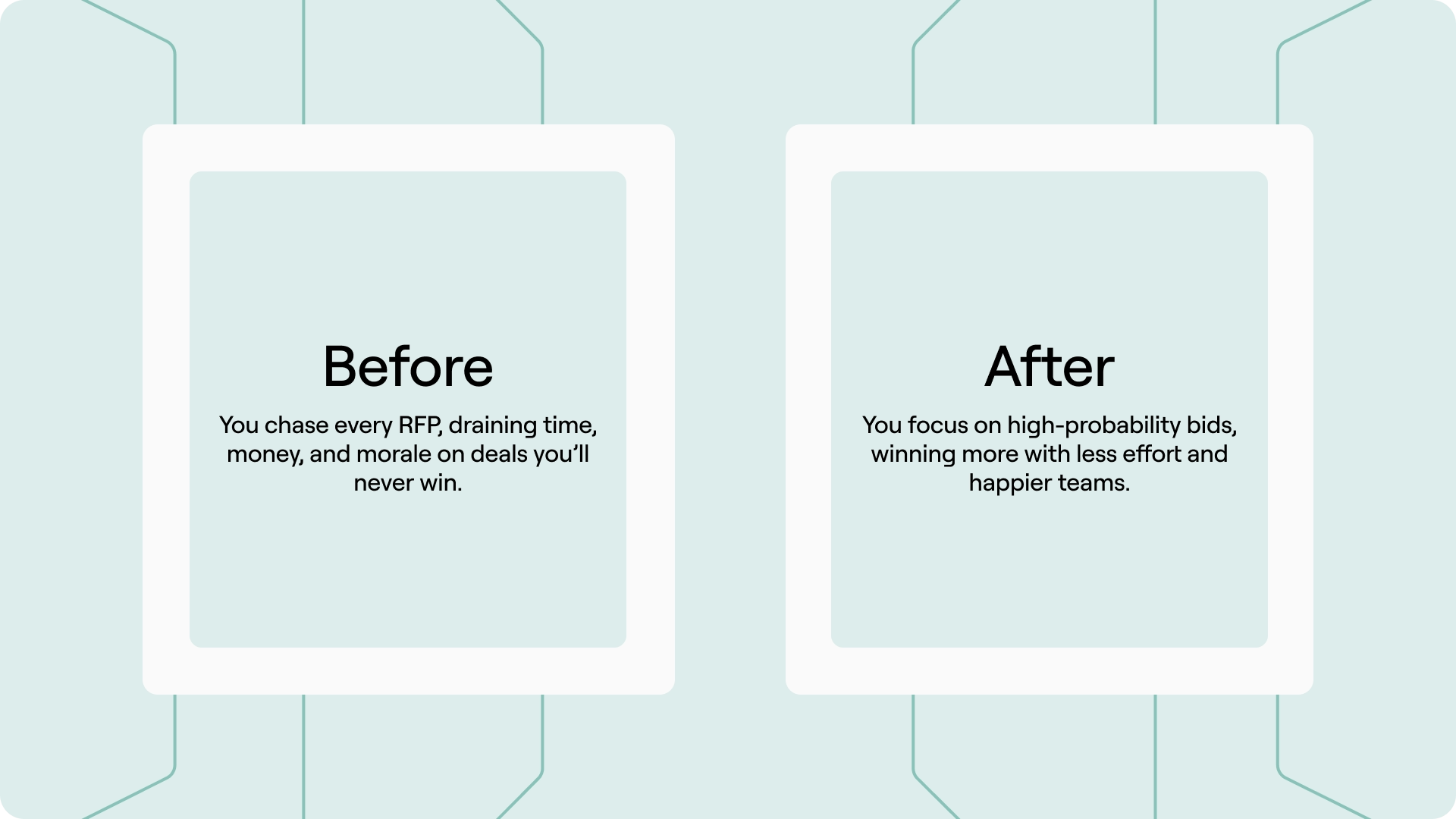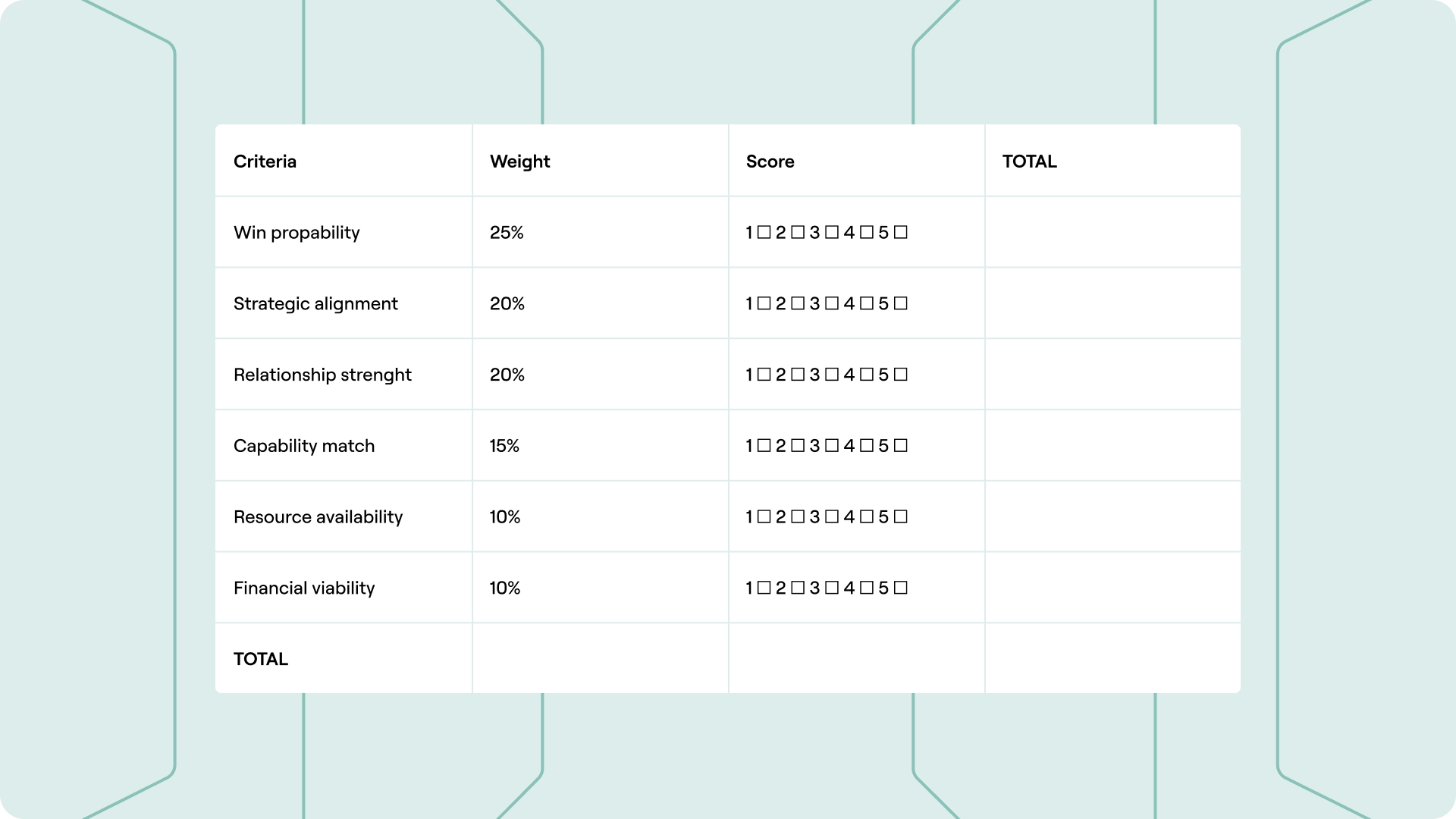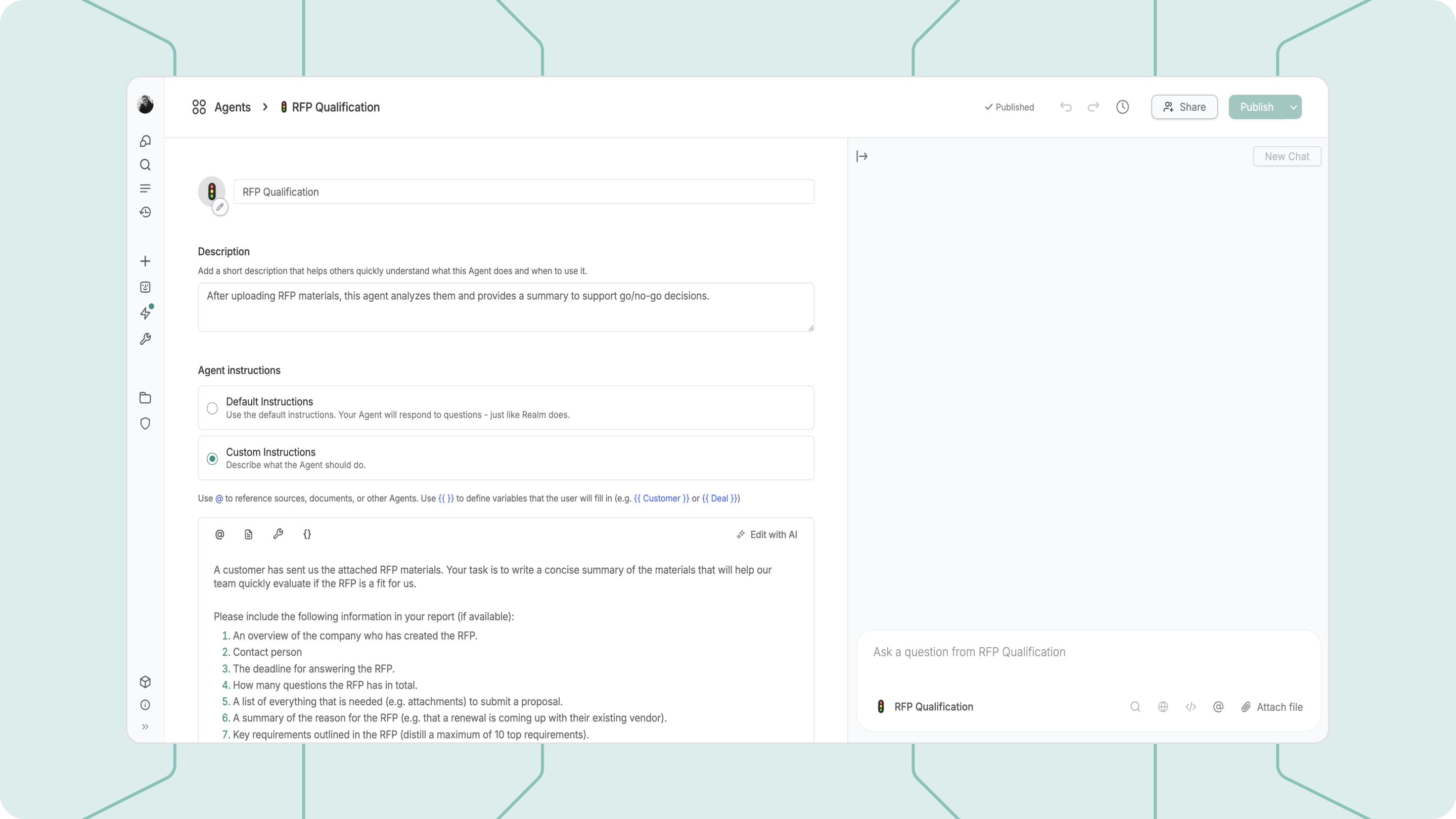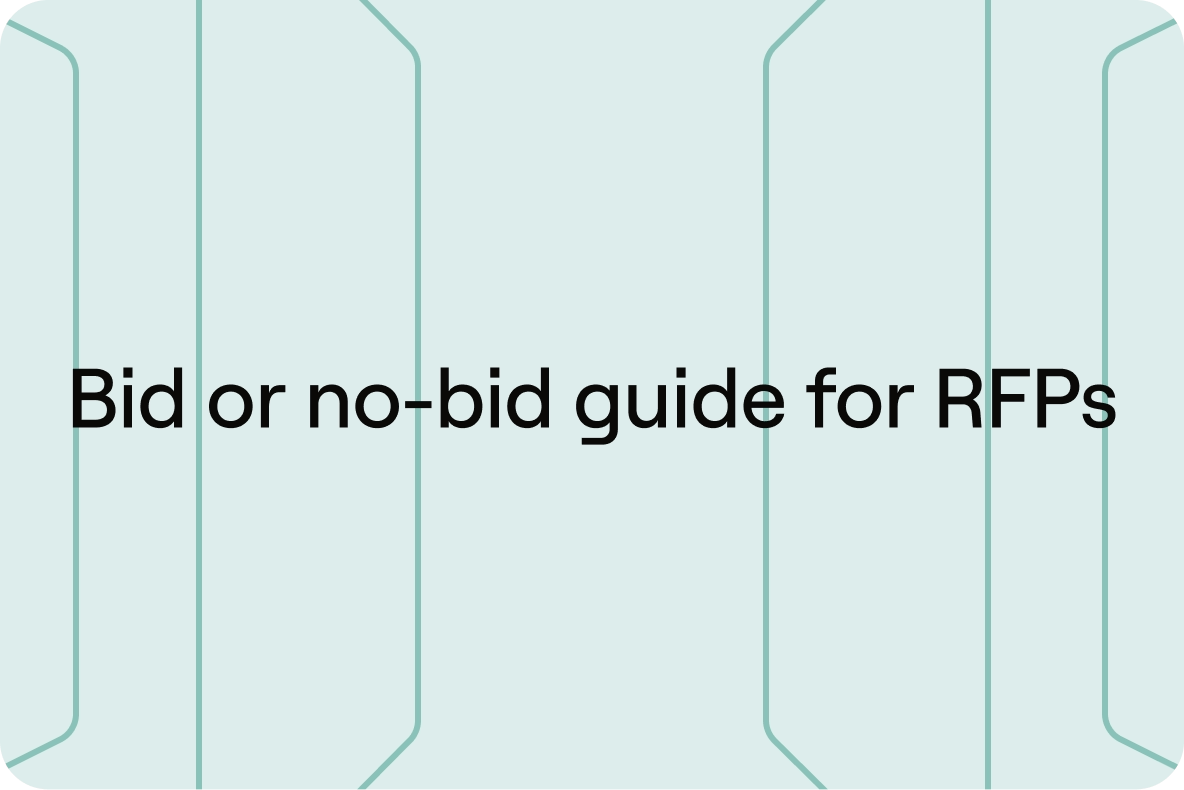Your proposal team just burned 40 hours on an RFP you never had a chance of winning.
The customer was planning to renew with the incumbent all along. Your sales rep knew the relationship was cold. But nobody asked the question that could have saved everyone a week of their lives: Should we even bid?
This scenario plays out every day across B2B companies. Teams chase dead-end RFPs because saying "yes" feels easier than saying "no." The result? Companies waste hundreds of thousands of dollars annually responding to unwinnable opportunities. Teams work nights and weekends. Burnout climbs. Win rates stay stuck below 20%.
A structured bid no bid decision process changes everything. Also called a go no go decision, it's how top-performing teams decide which opportunities deserve their limited resources, before anyone writes a single word of the proposal.
This guide covers what a bid no bid decision is, why it matters, how to build your own framework (the bid no bid decision matrix), and how tools like Realm's RFP Qualification AI Agent automate the most time-consuming parts of the process.
What is a bid/no-bid decision?
A bid no bid decision (also known as a go no go decision) is a formal evaluation process that determines whether your organization should invest resources in responding to a specific RFP, RFI, or RFQ before you start working on the response.
Think of it as a binary checkpoint. You receive an RFP. Before your team dives into writing, assembling case studies, and coordinating with subject matter experts, you pause and ask: Is this worth pursuing? The answer is simple: proceed with a full proposal effort, or decline the opportunity and invest those resources elsewhere.
The term "go/no-go" originates from NASA launch procedures. Before a rocket lifts off, mission control runs through a checklist with each station. "Flight dynamics, go or no-go?" "Propulsion, go or no-go?" Every system must give a "go" before proceeding. One "no-go" stops the launch.
The same principle applies to RFPs. You evaluate the opportunity against your success criteria. If critical factors check out, you proceed. If red flags emerge, you walk away, no matter how attractive the deal looks on paper.
Many companies make these decisions instinctively or politically, which leads to poor outcomes. An informal process looks like this: Sales receives an RFP, forwards it to the proposal team with "Can we respond to this?", someone skims the document, and the answer defaults to "yes" because nobody wants to tell the customer no.
A formal bid no bid process requires defined criteria, objective scoring, stakeholder involvement, and documented rationale.
Why your team needs a formal bid/no-bid process

Without a structured process, you waste money on unwinnable deals, burn out your best people, and underinvest in opportunities you could actually win.
The hidden cost of chasing every RFP
The average RFP response takes 20 to 40 hours. Complex responses such as technical proposals, government contracts, and major enterprise deals can exceed 200 hours.
If your average loaded cost per employee is $75 per hour, a 40-hour proposal costs $3,000 in labor alone. A 200-hour response? $15,000. Multiply that across dozens of RFPs per year, and the costs pile up fast. Research suggests that companies spend an average of $725,000 annually on bids that don't result in wins.
But the monetary cost is only part of the problem. There's also opportunity cost. Every hour your team spends on a low-probability RFP is an hour they're not spending on:
- High-probability deals that could actually close
- Nurturing customer relationships
- Strategic initiatives that move the business forward
We've seen this firsthand. One SaaS company was responding to 30+ RFPs per quarter with a three-person proposal team. Their win rate was 12%. The team was miserable. When we dug into the data, we found that more than half of those RFPs were cold inbound leads with no prior relationship, low budget alignment, or requirements that clearly favored a competitor. They were losing before they started.
What improves when you qualify rigorously
When you implement a formal bid no bid process, several things change:
- Win rates climb: Focused teams see 20 to 30 percentage points higher win rates simply by being more selective.
- Response quality increases: Concentrating resources on fewer bids allows deeper customization, stronger win themes, and better storytelling.
- Faster decisions: Clear criteria eliminate lengthy internal debates and political wrangling.
- Team satisfaction: People want to work on deals they can win.
5 signs you need a better qualification process
If any of these sound familiar, it's time to formalize your qualification process with a go no go decision matrix:
- Your win rate on competed opportunities is below 20%.
- Your proposal team is perpetually overloaded while sales complains about slow turnaround.
- Leadership frequently overrides the "no bid" recommendation for political reasons.
- You can't remember the last RFP you declined.
- Post-loss reviews reveal you were never competitive, but nobody realized it until after you submitted.
6 criteria for your bid/no-bid decisions

Winning bid no bid frameworks evaluate opportunities across six critical dimensions. These form the foundation of your bid no bid checklist.
1. Strategic alignment
Does this opportunity advance your business goals?
- Market fit: Does this customer fit your ideal customer profile (industry, company size, geography)?
- Product fit: Do they need what you're best at delivering?
- Strategic priority: Does winning this deal help you achieve specific goals (new market entry, reference customer)?
Let's go through an example: A cybersecurity vendor specializing in financial services receives an RFP from a large healthcare system. The deal is big, but they have limited healthcare experience. The strategic fit question is: Are we willing to invest in building that capability? If the answer is "no," it's an easy no-bid decision.
2. Win probability
What are our realistic chances of winning? This is the most important criterion.
- Incumbent status: Are you defending (high win probability) or displacing (low win probability)?
- RFP language: Does the requirements language favor you or a competitor's features? Watch for "wired" RFPs.
- Competitive landscape: How many competitors? Who are they?
Here's an example: You receive an RFP that references a specific competitor's proprietary technology seventeen times. The customer has been using that competitor for three years. Win probability? Close to zero. This is a strong indicator for a no-bid.
3. Relationship strength
What is the depth and quality of your connection with the buyer?
- Existing relationship: Have you worked with them before?
- Decision-maker access: Have you met with the people who will make the final call, or is all contact through procurement?
- Inside information: Do you understand their pain points, decision criteria, and internal politics beyond the RFP text?
If you've been nurturing a prospect for six months, met the buying committee, and tailored a demo, your relationship strength is high. If the RFP arrived cold via a public portal, it's low.
4. Capability and experience
Can you actually deliver what they're asking for?
- Requirements match: Can you fulfill everything, or will you need to "figure it out if we win?"
- Compliance factors: Do you meet mandatory qualifications (certifications, licenses, security clearances)?
- Relevant experience: Do you have case studies, references, and past performance in similar projects?
A red flag: If you can't meet a mandatory requirement, it's usually an automatic no-bid. I once bid on a project requiring a specific certification we didn't have. We won, then spent nine months and $200,000 trying to obtain the certification. We should have walked away.
5. Resource availability
Can we do this without breaking our team or jeopardizing other commitments?
- Proposal capacity: Can your team produce a quality response by the deadline without heroics?
- Delivery capacity: If you win, can you execute without jeopardizing existing commitments?
- Competing priorities: What gets delayed or deprioritized if you pursue this?
If responding to an RFP requires weekend work or late nights, it's either a strategic priority that deserves that investment, or we shouldn't bid. Don't normalize burnout.
6. Financial viability
Is the deal worth the effort?
- Deal size: Is the potential revenue large enough to justify the proposal investment?
- Profit margin: Does the expected margin justify the risk and resource investment?
- Budget alignment: Does their stated budget match your typical pricing?
A rule of thumb: If the proposal will cost 5% or more of the potential contract value to produce, and your win probability is below 30%, the expected ROI is likely negative. Walk away.
5 steps to build your bid/no-bid decision matrix

A bid no bid decision matrix converts subjective feelings into repeatable, data-driven decisions by scoring opportunities against weighted criteria and comparing the result to decision thresholds.
Step 1: Select your evaluation criteria
Start with the six core dimensions above. Break them down into 8 to 12 specific sub-criteria. Here's an example criteria list: Strategic fit, win probability, customer relationship, capability match, reference value, proposal complexity, resource availability, profit margin, compliance requirements.
Step 2: Weight criteria by importance
Not all factors matter equally. Weighting forces you to prioritize. Get leadership alignment on weights before you start scoring. Below you can find an example weighting, where total = 100%.
Step 3: Define your scoring scale
Use a consistent 1-to-5 scale (1 = Poor fit, 5 = Excellent). Crucially, define what each score means specifically for each criterion to eliminate subjective interpretation.
Example for "Win Probability" criterion:
- 1 (Poor): We're a challenger; incumbent is performing well; RFP favors competitor.
- 5 (Excellent): We're the incumbent and customer is satisfied, OR we have inside track and clear competitive advantage.
Step 4: Set decision thresholds
Here's how you can transform scores into clear actions using decision thresholds.
Step 5: Document and socialize the process
Create a bid no bid template (spreadsheet or form) that guides evaluators. Define roles (who scores, who approves) and set the cadence (score within 48 hours of RFP receipt). Create a decision log to track outcomes for continuous improvement.
Bonus: Download our bid/bo-bid decision matrix Excel template
To get going even faster, we've created go/no-go decision matrix Excel template you can download, share with your team, and tailor to your specific needs. You can access the template through this Google Drive link.
How to run effective go/no-go meetings
The best go no go decision meetings are short, focused, and data-driven.
Invite the right people
Keep the group small. Larger groups diffuse responsibility and slow decisions.
- Must attend: Opportunity owner (sales/BD lead), proposal manager, executive sponsor (for large deals).
- Should attend: Subject matter expert (technical/delivery lead), finance representative.
Prepare before the meeting
The meeting should validate analysis, not create it from scratch. Complete these in advance:
- Full RFP review (someone must read the entire document).
- Pre-scored decision matrix (opportunity owner submits preliminary scores with evidence).
- Competitive intelligence and customer research.
- Resource availability check.
Run the meeting in no more than 45 minutes
- Start with the bottom line: Opportunity owner summarizes the opportunity and states preliminary recommendation.
- Review each criterion (20 minutes): Walk through the pre-scored matrix. Surface disagreements and adjust scores based on group input.
- Identify deal-killers (5 minutes): Ask explicitly: "Is there any factor that should disqualify this opportunity regardless of score?"
- Make the decision (5 minutes): Decide Go, Go with Caution, or No-Go.
- Document rationale (5 minutes): Capture 3-5 bullet points explaining the decision.
Watch for cognitive biases
- Confirmation bias: Teams often look for reasons to say yes, not reasons to say no. Challenge assumptions.
- Sunk cost fallacy: Past investment is not a reason to make a bad decision today.
- Political pressure: Make the trade-offs visible. "If we pursue this opportunity with a 15% win probability, here are the three qualified opportunities we won't have resources for. Are we comfortable with that?"
Automate with Realm's RFP Qualification AI Agent

The biggest friction point in the bid no bid process is the initial analysis. Reading a 50-page RFP, extracting requirements, and identifying red flags can take two to three hours of manual effort.
That's why we built the RFP Qualification AI Agent.
Here's how it works:
- Extracts critical RFP details including company overview, contact person, submission deadline, total question count, and required attachments
- Analyzes the opportunity context by summarizing the reason for the RFP, such as vendor renewal, new initiative, or competitive displacement
- Distills key requirements by identifying and prioritizing the top 10 most important requirements from the RFP
- Assesses your fit by analyzing what type of vendor is likely to win and how well your capabilities align with their needs
- Calculates compliance percentage with an estimate of how compliant your solution is to the stated requirements
- Identifies capability gaps by highlighting specific areas where your offering may fall short of requirements
- Recommends next steps with actionable guidance on whether to pursue, what to emphasize, or what partnerships might be needed
- Works across languages by generating reports in English even when RFP materials are in other languages
The agent doesn't replace human judgment it augments it by providing instant, objective analysis.
Why teams use Realm for RFP qualification
Realm is an AI-native RFP software that supports your team from go/no-go analysis to responses and project management:
- Speed: Reduce initial RFP analysis time by 70-80%.
- Consistency: AI applies the same criteria every time, eliminating human bias and subjectivity.
- Early warning: Identifies deal-killers before you invest significant time.
- Response automation: If you make decision to bid Realm automatically drafts up to 80% of responses.
- Streamline project managent: Realm makes it easy to review and edit the drafted answers and assign them for SMEs for approval.
What to do after you decide
The bid no bid decision is just the beginning and your next actions determine whether you maximize the opportunity or learn from it.
If you decide to bid: Lock in resources and develop strategy
- Send intent to bid letter: Take a few minutes to send your prospect a letter of intent to bid.
- Immediately allocate resources: Block calendars and confirm availability.
- Schedule proposal kickoff within 48 hours: Align on win themes and differentiation strategy.
- Turn weaknesses into strategy: Revisit your decision matrix. Where did you score lowest? Those are your proposal vulnerabilities. Address them head-on in the proposal (e.g., low relationship score means you lead with third-party validation and case studies).
If you decide not to bid: Close the loop professionally
- Communicate internally first: Notify sales and account management.
- Write a no-bid letter: Preserve the relationship by being honest but diplomatic about why you are not the best fit for this particular engagement.
- Set a follow-up reminder: Check back in 3-6 months. Many RFPs result in failed implementations or changed requirements and your future opportunity may be even better.
Track results and improve your process over time
Maintain a decision log tracking the opportunity, final score, decision, and eventual outcome (Won/Lost). Quarterly, calculate your win rate on pursued opportunities and compare the average score of won deals versus lost deals. Adjust your criteria weights based on this data. Celebrate smart "no" decisions to reinforce that walking away is a strategic choice.
7 common bid/no-bid process mistakes to avoid

Mistake #1: Skipping the process for "strategic" opportunities
- The trap: "This customer is too important to evaluate, we have to respond no matter what."
- Better approach: Strategic importance is one criterion, not an automatic override. Score it honestly. If the score is low, make the resource cost explicit to the executive sponsor.
Mistake #2: Scoring without data
- The trap: "I think our win probability is pretty good" based on gut feel
- Better approach: If you can't answer a criterion with data, your score should reflect that uncertainty (mark as "unknown" or score low). Require evidence for high scores.
Mistake #3: Political pressure overrides the process
- The trap: Your VP of Sales insists on bidding despite a low score.
- Better approach: Make the trade-offs visible. "If we pursue this opportunity with a 15% win probability, here are the three qualified opportunities we won't have resources for. Are we comfortable with that?"
Mistake #4: Not tracking outcomes
- The trap: You decide go or no-go, then never revisit the decision to see if you were right.
- Better approach: Maintain a decision log. Quarterly review: Did high-scoring opportunities actually convert at higher rates? Adjust your criteria weights based on what actually predicts wins.
Mistake #5: Making it too complicated
- The trap: A 35-question assessment that takes four hours to complete.
- Better approach: Start with 8 to 10 criteria and a 30-minute meeting. Complexity creates friction, and friction leads to teams skipping the process.
Mistake #6: Ignoring deal-killers
- The trap: The overall score looks acceptable (68%), so you proceed despite one major red flag (e.g., missing a mandatory certification).
- Better approach: Explicitly identify deal-killers. If a deal-killer exists, it's an automatic no-go, regardless of overall score.
Mistake #7: Forgetting to communicate the "no" decision
- The trap: You decide not to bid but never tell the customer.
- Better approach: Send a polite decline message that keeps the door open. Thank them for the opportunity, briefly explain why (diplomatically), and express interest in future opportunities that align better with your strengths.
Final thoughts on RFP the RFP go or no-go process
The best proposal teams don't win because they write better than everyone else. They win because they only fight battles they can win.
A structured bid no bid decision process protects your most valuable asset: your team's time and attention. The paradox is that saying "no" more often leads to winning more. Focus is a competitive advantage.
You don't need a perfect system to start. Even a simple 10-question bid no bid checklist is infinitely better than "let's just respond and see what happens." Start there. Run it for a quarter. Track your results. Refine based on what you learn.
The teams that win consistently have three things in common:
- They qualify ruthlessly. Most RFPs don't deserve a response.
- They use data, not politics. Gut feel and executive pressure don't override the framework.
- They leverage tools. Whether it's a spreadsheet or Realm's RFP Qualification AI Agent, they make the process fast and repeatable.
Here's your action item: Review your last 10 RFP decisions. How many should you have walked away from? What did pursuing those opportunities cost you in time, in money, in missed alternatives, in team morale?
Now imagine if you could get those resources back to invest in opportunities you could actually win.
That's what a throughout bid no bid decision delivers.


